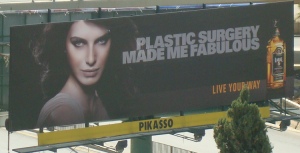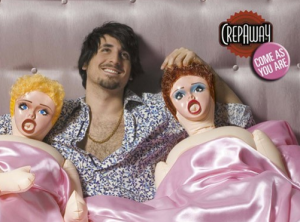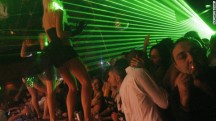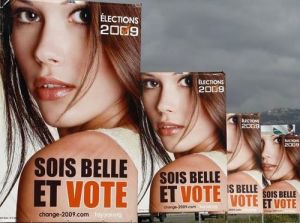The world attaches certain stereotypes to all societies. Asians are good at math and cannot drive, African Americans are good at basketball and like to fight, Americans are fat and racist, and Lebanese like to party and get plastic surgery. Whether they are emphasized through international media or social circles, the world has this conventional image of the Lebanese community. However, these stereotypes are slowly transforming into an accurate portrayal of Lebanese, instead of just a mere misrepresentation. Perhaps one of the reasons is because they are advertised and promoted in the Lebanese media itself. This project explores how Lebanese advertisements reemphasize two Lebanese stereotypes formed in international media; the Lebanese party animals and the Lebanese Barbies. The paper will begin with a two-part literature analysis, first discussing the affects of advertisements on people, and second showing supporting evidence that these two conventional images are recognized and established by worldwide media. Then, it will critically analyze six advertisements in Lebanon that portray each stereotype. Finally, it will discuss effects the Lebanese media has caused on society by portraying it in a stereotypical way as well as give audiences media literacy tips that will help them become more critical when looking at ads.
All posts in category Media Portrayals of Lebanese Stereotypes
Introduction
Posted by dalia813 on May 17, 2013
https://daliamediablog.wordpress.com/2013/05/17/introduction/
Literature Review – The Influence of Advertisements
The first portion of my literature review will briefly discuss the effects advertising has on society. One of the primary focuses of advertisements is to influence the behavior of customers (Blech & Blech, 2012). However, this influence of behavior does not only represent swaying consumers to buy products. By using specific images and specific people, advertisements can create needs and faults consumers never knew they had (Blech & Blech, 2012). There are several social and ethical criticism of advertising, including how it can be untruthful and deceptive towards consumers (Blech & Blech, 2012). While deception is based on how the consumer perceives the ad, marketers knowingly and deliberately include specific factors in an ad in order to get the consumer to discern it in a specific way.
Another social criticism found in ads is their display sexual appeals and perpetual stereotyping towards women (Blech & Blech, 2012). While such images are meant to catch audience attention, they also influence the audiences by being implicitly suggestive (Blech & Blech, 2012). Such representation in mass media sends a message to society that reinforces these images as acceptable. In turn, media can impact lifestyles and values of consumers as well (Blech & Blech, 2012).
In Lebanon, ads are more prevalent than ever. Everywhere you go and everywhere you look you will see a different advertisements. As evident in this part of the literature review, ads can have an immense impact on consumer behavior. It is for this reason I decided to focus on advertisements as opposed to other media in Lebanon.
Posted by dalia813 on May 17, 2013
https://daliamediablog.wordpress.com/2013/05/17/literature-review-the-influence-of-advertisements/
Literature Review – The Worlds Perspective
Media has a large impact on public opinion and can easily create images and stereotypes of different groups and societies. After extensive research, I found that two of the most prominent stereotypes in international media about Lebanese society are how Lebanese are portrayed as partiers and how Lebanese woman are portrayed as plastic. This part of the literature review elaborates on articles and journals that support and aid in forming these stereotypes.
The review about the Lebanese societal stereotype of a partying audience is found in several international mediums. Four different articles from The New York times identify Beirut as a “party capital” (The New Party, 2009). The articles describe activities relating to clubbing, drinking, and nightlife, naming places such as BO18, Acid, and SkyBar as must go places for tourists (Healy, 2009).
Additionally, three videos by CNN title Lebanon as a “world class party scene” showing several clips of how clubbing has become one of the biggest parts of the Lebanese society (CNN: Beirut #1, n.d.). One of the videos takes the audience through a day in Beirut, visiting not only night parties, but day parties as well. Thus, the video literally implies that partying is an activity done around the clock by Lebanese. Another CNN video focuses strictly on the Lebanese clubbing scene. This video markets the political instability of Lebanon, claiming that it creates the partying society we have today; living as if there is no tomorrow, literally (Beirut Nightlife, 2011). The video claims that “clubs thrive on political instability” thus creating the nature for the Lebanese partying stereotype (Beirut Nightlife, 2011). In this video, Fadi Abboud from the Lebanese Ministry of Tourism spoke of Lebanon having the best clubs in the world, suggesting that clubbing makes up a big part of the Lebanese culture and is one of the most done activities in Lebanon (Beirut Nightlife, 2011). Furthermore, CNN travel articles on Beirut often only talk about its best bars and clubs, as opposed to listing something such as the best restaurant or tourist attractions (Brunt, 2013). Additionally, photos in the articles complement the text by showing wild pictures of nightlife, with captions such as, “nightlife capital” and “real underground clubbing” (Brunt, 2013).
Additionally, an article in a magazine titled Middle East, describes how Americans see Lebanese and what they know of Lebanon. There comments regarded “fancy Mediterranean beach clubs and buzzing nightlife” (Wells, 2009). Also, the vodka brand Smirnoff in 2010 launched ‘The Smirnoff Nightlife Exchange Program,” that cooperated with 14 countries that have “respected nightlife figures” (Smirnoff, 2010). One of these countries was Lebanon. This is another aspect that shows how the world as stereotypes Lebanon as a partying society.
These large international media hubs create a large impact on the world’s view of Lebanon, since they are known to be reliable world-read sources. Articles and videos such as these that strictly focus Lebanese as party animals are some of the main roots that create the stereotype of Lebanese in an outside audience. Overall, we can conclude that there is definitely a stereotype out there for Lebanese to be party animals.
Just like with the previous stereotype, the Lebanese “Barbie” is another Lebanese cliché that has been overblown in international media, making it an established stereotype for Lebanese. The amount of plastic surgery done in Lebanon has increased a tremendous amount over the past few years and 20 to 40% of patients are now coming from outside (Heather, 2010). In fact, it has practically become a tourist attraction. The problem with this, as previously mentioned with clubbing, is that it creates an image that cosmetic surgery is a common activity in Lebanese culture. Once again, large media outlets such as CNN draw attention to such aspects and identify them with the Lebanese society, further enhancing the stereotype. One article by CNN began with, “while the search for inner beauty is this month drawing Muslims to Mecca for the Hajj pilgrimage, a different kind of search — this time for beauty of a more obvious kind — is drawing many from the Middle East to another location [Lebanon]” (Neild, 2010). However, Lebanon does not have the highest rates for plastic surgery per capita, Hungary and South Korea do (Heather, 2010). In spite of that, these two countries do not have the same reputation or stereotype on women (or men) in their countries because cosmetic procedures are not advertised in their local media.
What can be gathered from this literature review is that the stereotypes that all Lebanese women are plastic and Lebanese in general are hard-core partiers are very acclaimed. We can see that several international sources have written articles and composed media portraying Lebanese under these two stereotypes. As a result we can conclude that these are two of the ways Lebanese are viewed as by outside countries.
Posted by dalia813 on May 17, 2013
https://daliamediablog.wordpress.com/2013/05/17/literature-review/
The Lebanese Party Animal & Tourism
This advertisement is a flight landing video arriving to Beirut on Middle East Airlines taken by Jad Melki. The video is 80 seconds long, 50 of which show clubbing and nightlife of Beirut. The camera zooms in on people – or should I say girls – several times, showing them dancing and going crazy as if there is no tomorrow. There are also scenes showing a wider angle of the entire club. You see that it’s packed, as if everyone in Beirut is there. By showing the amount of people crowded at the clubs, it implies that it’s an activity that most Lebanese do. Additionally, landing videos on airlines are meant to show what locals do in that country, so that tourists can go enjoy the same activities and really feel the culture. Since 60% of the video was dedicated to showing nightlife and clubbing, it indicates Lebanese are party animals, since the main activity they seemingly take part in is clubbing.
Posted by dalia813 on May 17, 2013
https://daliamediablog.wordpress.com/2013/05/17/the-lebanese-party-animal-tourism/
The Lebanese Party Animal & Lebanese Brew

Lebanese media reemphasizes the stereotype of a party animal by showing that this is how Lebanese would spend their last summer on earth (Lebanese Brew, 2012).
The Lebanese Brew “Last Summer on Earth” campaign is another advertisement in Lebanese media that stresses the party animal stereotype formed outside. This campaign shows how Lebanese people would spend what is supposedly their last summer on Earth. Of course the campaign shows images of Lebanese doing crazy daring activities and partying with alcohol. Once again, Lebanese media is supporting a stereotypical image created of them, and doing so justifies this stereotype to people outside Lebanon (Lebanese Brew, 2012). Although it is understandable that alcohol is usually consumed at parties, such beverages – especially beer – can be shown in other environments as well, such as a barbeque.
Posted by dalia813 on May 17, 2013
https://daliamediablog.wordpress.com/2013/05/17/the-lebanese-party-animal-lebanese-brew/
The Lebanese Party Animal & Absolut Beirut
This Absolute Vodka advertisement, which in Beirut was called Absolute Beirut is another example of the re-eoxcertaition of a partying stereotype in Lebanese media. As you can see from the image, the body parts of the people in the ad form the shape of a vodka bottle. You can also tell from the way they are dressed and the table that they are in a bar or a club. Though, again, alcohol is usually consumed at clubs, the fact that Lebanese media let a multinational brand customize this advertisement to them [Absolute Beirut] shows how the Lebanese media supports the stereotypes that it’s bound by.
Posted by dalia813 on May 17, 2013
https://daliamediablog.wordpress.com/2013/05/17/the-lebanese-party-animal-absolut-beirut/
The Lebanese Barbie & Whiskey
 Many advertisements in Lebanon feature woman who appear to have had cosmetic surgery, and as a result implies that these are the women that represent all Lebanese females. My first example is a billboard ad for a whiskey label that reads, “Plastic surgery made me fabulous…Live your way,” with a very bold and fierce looking woman on the billboard. This ad does not need interpretation of any kind, its clear and straight forward. It is telling everyone that plastic surgery is the answer to finally being able to feel good about yourself. The slogan “live your way” makes the audience think they need plastic surgery, and by getting it they are taking control of their own lives. Thus, as very bluntly evident in this ad, Lebanese media are encouraging more Lebanese to use plastic surgery and are applauding the fact that they are represented by this stereotype.
Many advertisements in Lebanon feature woman who appear to have had cosmetic surgery, and as a result implies that these are the women that represent all Lebanese females. My first example is a billboard ad for a whiskey label that reads, “Plastic surgery made me fabulous…Live your way,” with a very bold and fierce looking woman on the billboard. This ad does not need interpretation of any kind, its clear and straight forward. It is telling everyone that plastic surgery is the answer to finally being able to feel good about yourself. The slogan “live your way” makes the audience think they need plastic surgery, and by getting it they are taking control of their own lives. Thus, as very bluntly evident in this ad, Lebanese media are encouraging more Lebanese to use plastic surgery and are applauding the fact that they are represented by this stereotype.
Posted by dalia813 on May 17, 2013
https://daliamediablog.wordpress.com/2013/05/17/the-lebanese-barbie-whiskey/
The Lebanese Barbie & Crepaway
This ad is from the Crepaway campaign “Come as You Are” that features images such as a woman who evide ntly just had a nose job and a man lying down with two plastic (literally) female dolls next to him. Here, Lebanese advertising is promoting the fact that plastic Lebanese woman are in fact natural, as it couples these images with the slogan “come as you are” (Bontems, 2009). Another campaign by Crepaway, called “All Good,” is a video ad that frequently shows a woman with a boob job, and zooms in on her breasts each time the camera turns to her (Crepaway’s ‘All Good’, 2013). Since Crepaway represents a Lebanese brand and the people in these videos represent Lebanese people, it is showing that Lebanese in fact do conform to the stereotype of cosmetic surgery since that’s how the Lebanese women are being represented.
ntly just had a nose job and a man lying down with two plastic (literally) female dolls next to him. Here, Lebanese advertising is promoting the fact that plastic Lebanese woman are in fact natural, as it couples these images with the slogan “come as you are” (Bontems, 2009). Another campaign by Crepaway, called “All Good,” is a video ad that frequently shows a woman with a boob job, and zooms in on her breasts each time the camera turns to her (Crepaway’s ‘All Good’, 2013). Since Crepaway represents a Lebanese brand and the people in these videos represent Lebanese people, it is showing that Lebanese in fact do conform to the stereotype of cosmetic surgery since that’s how the Lebanese women are being represented.
Posted by dalia813 on May 17, 2013
https://daliamediablog.wordpress.com/2013/05/17/the-lebanese-barbie-crepaway/
The Lebanese Barbie & Politics
This ad example is one for a political campaign.
The ad shows a very beautiful woman with a very small nose, and the caption in French reads, “Be beautiful and vote.” This ad represents Lebanon reemphasizing a plastic stereotype because in the majority of ads, the women in them appear to have done some type of cosmetic alteration and also simply have nothing to do with the ad. It gives the impression that these are and should be the women that represent Lebanon. The ad was for General Michel Aoun, and his comment on it was, “I am proud of this campaign because it reflects the beauty of our country,” implying again that these woman who are beautiful from plastic surgery represent the woman of Lebanon (Lutz, 2009). Thus, the Lebanese media – and in this case the government too – are reinforcing an outside stereotype that Lebanese woman are plastic.
Posted by dalia813 on May 17, 2013
https://daliamediablog.wordpress.com/2013/05/17/the-lebanese-barbie-politics/
So What?
So what? So what if Lebanese are stereotyped as party animals and plastic Barbies to the World? And so what if the Lebanese media reinforces these stereotypes. It helps our economy, it boosts out tourist sector, and it puts our name on the map. Lets not forget that at the end of the day, stereotypes do come from somewhere; Lebanese do like to party and get plastic surgery. So what? It all comes down to what effects reemphasizing such stereotypes in Lebanese media have on Lebanese society.
Advertising is popular form of communication in Lebanon. The purpose of advertising is simple, to persuade a mass audience to believe in ideas and opinions and influence specific action (Russeau, n.d.). Repeating the same points and correctly positioning ads will allow people believe that by agreeing to them, they will fit into society better (Russeau, n.d.). Thus, by supporting party animal and plastic Barbie stereotypes in their own media, Lebanon is encouraging its citizens to be exactly like that, even when a lot of them are not. It may pressure people into drinking or beautiful girls to get a nose job, because seeing multiple ads about it makes it seem like everyone else is doing it anyway.
The ads portraying Lebanese women with plastic surgery seem to have the greater and more consequential effect on Lebanese society. Several plastic surgeons admit that a handful of their patients are very pretty and do not need any type of cosmetic change, but “you just have to do what the patient wants” (Tourists Flock, 2010). Additionally, an article from NOW discusses how all the media done about plastic surgery is making Lebanese woman afraid to be natural (Are Lebanese women, 2011). The advertisements encourage invite women into plastic surgery by convincing them that it will yield liberation (Advertising Dangers, 2001). As a result of Lebanese media, any woman can alter how she looks with cosmetic surgery in order to “look like a woman she saw in an advertisement” (Wazeer, 2012). Because of the emphasis on such conventional images in Lebanese media, Lebanese are conforming themselves to stereotypes. Now, what was once a widely held but oversimplified image of Lebanese is becoming a widely held realistic image of Lebanese.
Posted by dalia813 on May 17, 2013
https://daliamediablog.wordpress.com/2013/05/17/media-portrayals-of-lebanese-stereotypes-so-what/






